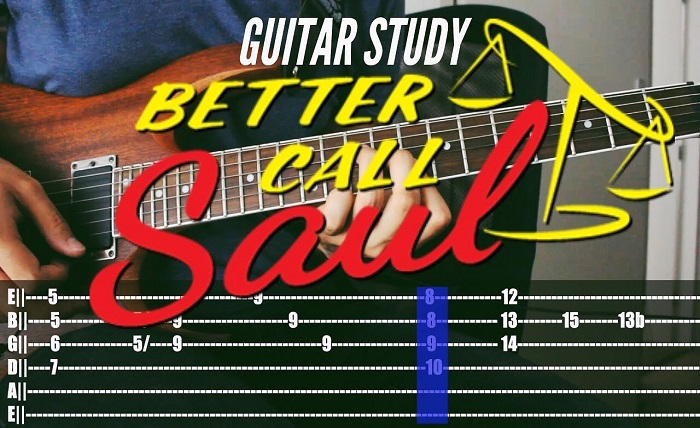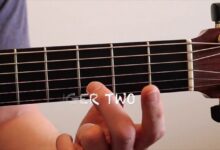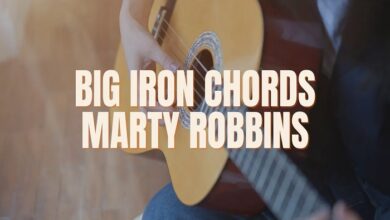How to Play the Better Call Saul Theme Chords on Guitar

Better Call Saul is a popular American television series that is a spin-off of the acclaimed drama Breaking Bad. The show follows the exploits of Jimmy McGill, a small-time lawyer who eventually becomes the notorious criminal lawyer Saul Goodman. The show has a catchy and distinctive theme song that plays during the opening credits, composed and performed by the British rock band Little Barrie. In this article, we will show you how to play the Better Call Saul theme on guitar, using tabs from various online sources.
Chords
A C#m C slight bend e|----5~~------9--------8~~-----12-10------------------------------------------| B|----5~~--7/9---9------8~~-----10----13b--------------------------------------| G|----6~~--7/9----9~----9~~-----11---------------------------------------------| D|----7~~---------------10~~----12---------------------------------------------| A|-----------------------------------------------------------------------------| E|-----------------------------------------------------------------------------| A A7 E5 Palm muted e|----5~~------9-------------------------------------------------------------| B|----5~~-------8~~----------------------------------------------------------| G|----6~~---/9---------------------------------------------------------------| D|----7~~--------------------------------------------------------------------| A|--------------------2---2-2------------------------------------------------| E|--------------------0---0-0------------------------------------------------| Rake e|----------------------------------------------------------------------------| B|----------------------------------------------------------------------------| G|----9--8--7--5-----5-7---------------------Song cuts off -------------------| D|----x-----------------------------------------------------------------------| A|----x---------6h7-------0-3br-0---------------------------------------------| E|----------------------------------------------------------------------------| Please Rate and leave comments! ************************************ | x Dead note | h Hammer-on | br Bend release | / Slide up | ~ Vibrato ************************************
What are Tabs?
Tabs, or tablature, are a way of writing music for stringed instruments, such as guitar, bass, or ukulele. Tabs use numbers and symbols to indicate which frets and strings to play, instead of using standard musical notation. Tabs are easy to read and follow, especially for beginners who may not be familiar with musical theory or notation. Tabs can also show techniques such as bends, slides, hammer-ons, pull-offs, vibrato, and more.
How to Read Tabs
Tabs are written using six horizontal lines that represent the six strings of the guitar, from the lowest (thickest) string to the highest (thinnest) string. The numbers on the lines indicate which frets to press down on the corresponding strings. For example, a 3 on the second line from the bottom means to press down the third fret on the fifth string (the A string). A 0 means to play the string open, without pressing any frets. A x means to mute the string, either by lightly touching it with your fretting hand or by using your palm or pick.
Some tabs also use symbols to show how to play certain notes or techniques. Here are some common symbols and what they mean:
- / : slide up
- \ : slide down
- h : hammer-on
- p : pull-off
- b : bend
- r : release bend
- ~ : vibrato
- ( ) : optional note
- [ ] : harmonic
- < > : artificial harmonic
- P.M. : palm mute
How to Play the Better Call Saul Theme
The Better Call Saul theme is a short and simple piece that uses mainly power chords and single notes. It has a heavy tremolo effect that gives it a surf rock vibe. The theme is divided into two parts: the intro and the main riff.
Intro
The intro consists of four chords: A, C#m, C, and E5. The A and C#m chords are played with a slight bend on the first string, using a tremolo bar or by pushing the string with your finger. The C chord is played with a slide up from the eighth fret to the twelfth fret on the first string. The E5 chord is played with palm muting on the sixth and fifth strings. Here is how the intro looks like in tabs:
e|—-5~~——9——–8~~—–12-10——————————————|
B|—-5~~–7/9—9——8~~—–10—-13b————————————–|
G|—-6~~–7/9—-9~—-9~~—–11———————————————|
D|—-7~~—————10~~—-12———————————————|
A|—————————————————————————–|
E|—————————————————————————–|
e|—-5~~——9————————————————————-|
B|—-5~~——-8~~———————————————————-|
G|—-6~~—/9—————————————————————|
D|—-7~~——————————————————————–|
A|——————–2—2-2————————————————|
E|——————–0—0-0————————————————|
Main Riff
The main riff is played after the intro and repeats until the end of the theme. It starts with a rake on the ninth fret of the third string, followed by a hammer-on from the sixth fret to the seventh fret on the fourth string. Then it plays an open A string and a bend-release on the third fret of the sixth string. The riff ends with an optional note on the fifth fret of the first string. Here is how the main riff looks like in tabs:
e|—————————————————————————-|
B|—————————————————————————-|
G|—-9–8–7–5—–5-7———————Song cuts off ——————-|
D|—-x———————————————————————–|
A|—-x———6h7——-0-3br-0———————————————|
E|—————————————————————————-|
Sources
We used tabs from three different online sources to write this article: Ultimate Guitar, Songsterr, and Tv Theme. You can check out these sources for more details and variations of how to play the Better Call Saul theme on guitar.
Read more about nextexam-tak
Conclusion
The Better Call Saul theme is a fun and easy song to play on guitar, especially if you use tabs. It has a catchy melody and a cool tremolo effect that makes it stand out. You can learn how to play the theme by following the tabs we provided, or by watching some videos on YouTube. We hope you enjoyed this article and learned something new. Happy playing!
Read more about nextexam-tak







